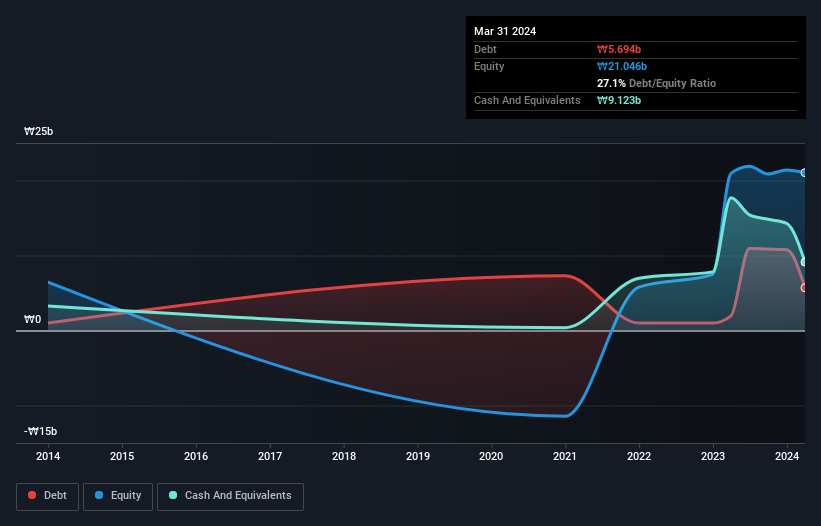Legendary fund manager Li Lu (who Charlie Munger backed) once said, 'The biggest investment risk is not the volatility of prices, but whether you will suffer a permanent loss of capital.' It's only natural to consider a company's balance sheet when you examine how risky it is, since debt is often involved when a business collapses. As with many other companies RAONTECH Inc. (KOSDAQ:418420) makes use of debt. But is this debt a concern to shareholders?
What Risk Does Debt Bring?
Debt and other liabilities become risky for a business when it cannot easily fulfill those obligations, either with free cash flow or by raising capital at an attractive price. Part and parcel of capitalism is the process of 'creative destruction' where failed businesses are mercilessly liquidated by their bankers. However, a more frequent (but still costly) occurrence is where a company must issue shares at bargain-basement prices, permanently diluting shareholders, just to shore up its balance sheet. By replacing dilution, though, debt can be an extremely good tool for businesses that need capital to invest in growth at high rates of return. The first step when considering a company's debt levels is to consider its cash and debt together.
View our latest analysis for RAONTECH
What Is RAONTECH's Debt?
As you can see below, at the end of March 2024, RAONTECH had ₩5.69b of debt, up from ₩1.96b a year ago. Click the image for more detail. But on the other hand it also has ₩9.12b in cash, leading to a ₩3.43b net cash position.

How Strong Is RAONTECH's Balance Sheet?
According to the last reported balance sheet, RAONTECH had liabilities of ₩2.06b due within 12 months, and liabilities of ₩6.98b due beyond 12 months. Offsetting these obligations, it had cash of ₩9.12b as well as receivables valued at ₩1.42b due within 12 months. So it can boast ₩1.50b more liquid assets than total liabilities.
This state of affairs indicates that RAONTECH's balance sheet looks quite solid, as its total liabilities are just about equal to its liquid assets. So while it's hard to imagine that the ₩128.0b company is struggling for cash, we still think it's worth monitoring its balance sheet. Simply put, the fact that RAONTECH has more cash than debt is arguably a good indication that it can manage its debt safely. When analysing debt levels, the balance sheet is the obvious place to start. But it is RAONTECH's earnings that will influence how the balance sheet holds up in the future. So when considering debt, it's definitely worth looking at the earnings trend. Click here for an interactive snapshot.
In the last year RAONTECH had a loss before interest and tax, and actually shrunk its revenue by 3.3%, to ₩11b. We would much prefer see growth.
So How Risky Is RAONTECH?
Statistically speaking companies that lose money are riskier than those that make money. And we do note that RAONTECH had an earnings before interest and tax (EBIT) loss, over the last year. And over the same period it saw negative free cash outflow of ₩13b and booked a ₩2.8b accounting loss. Given it only has net cash of ₩3.43b, the company may need to raise more capital if it doesn't reach break-even soon. Even though its balance sheet seems sufficiently liquid, debt always makes us a little nervous if a company doesn't produce free cash flow regularly. When analysing debt levels, the balance sheet is the obvious place to start. But ultimately, every company can contain risks that exist outside of the balance sheet. For example, we've discovered 4 warning signs for RAONTECH (1 shouldn't be ignored!) that you should be aware of before investing here.
If, after all that, you're more interested in a fast growing company with a rock-solid balance sheet, then check out our list of net cash growth stocks without delay.
New: AI Stock Screener & Alerts
Our new AI Stock Screener scans the market every day to uncover opportunities.
• Dividend Powerhouses (3%+ Yield)
• Undervalued Small Caps with Insider Buying
• High growth Tech and AI Companies
Or build your own from over 50 metrics.
Have feedback on this article? Concerned about the content? Get in touch with us directly. Alternatively, email editorial-team (at) simplywallst.com.
This article by Simply Wall St is general in nature. We provide commentary based on historical data and analyst forecasts only using an unbiased methodology and our articles are not intended to be financial advice. It does not constitute a recommendation to buy or sell any stock, and does not take account of your objectives, or your financial situation. We aim to bring you long-term focused analysis driven by fundamental data. Note that our analysis may not factor in the latest price-sensitive company announcements or qualitative material. Simply Wall St has no position in any stocks mentioned.
Have feedback on this article? Concerned about the content? Get in touch with us directly. Alternatively, email editorial-team@simplywallst.com
About KOSDAQ:A418420
RAONTECH
A fabless semiconductor company, specializes in microdisplay solution for AR/VR/MR and mobile TV SoC in South Korea and internationally.
Excellent balance sheet with low risk.
Similar Companies
Market Insights
Community Narratives



